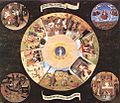Anger facts for kids
Anger is a strong feeling that everyone has. It's a natural feeling that humans and many animals share. You might feel angry when you are threatened, treated unfairly, or don't get something you really need. Rage is a very strong kind of anger.
What is Anger?
Anger is a normal feeling. It's a strong, uncomfortable reaction to something that bothers you. It's important to know the difference between feeling angry and acting aggressively. Aggression means hurting someone, either with words or actions. Anger can make you want to be aggressive, but it doesn't always lead to it. You can feel angry without being aggressive.
Think of anger like a pressure cooker. If you keep all your angry feelings inside, the pressure builds up. Eventually, it might explode if you don't find a way to let it out safely.
People show anger in different ways. They might show it on their face, with their body language, or by not trying to understand others. Sometimes, people might even act aggressively in public, like punching a wall. Animals and humans might try to scare others when they are angry. They might make loud sounds, try to look bigger, show their teeth, or stare.
When you face a challenge, you might feel angry or scared. It can be hard to decide if you should face the challenge or walk away. In animal behavior, this is called the "fight or flight" choice. You either stay and deal with the problem, or you run away from it.
How Anger Changes Your Body
When you get angry, your body changes quickly. Your heart beats faster, and your blood pressure goes up. Blood pressure is the force of your blood pushing against the walls of your blood vessels. Your body also releases more hormones like adrenaline and noradrenaline. These are chemicals that send messages to different parts of your body to make changes.
The levels of adrenaline and noradrenaline in your body go up when you're angry, but not for very long. Adrenaline quickly gets your body ready to act when there's trouble. It sends more oxygen and glucose (which your body uses for energy) to your brain and muscles. It also slows down less important things your body is doing, like digesting food.
Noradrenaline is released when you are under stress. It goes to parts of your brain that control how much you pay attention and how you react. This hormone is very important for the "fight-or-flight" response. It makes your heart beat faster, releases stored glucose for energy, and sends more blood to your muscles.
Images for kids
-
Facial expression of a person having emotions of Anger.
-
The Anger of Achilles, by Giovanni Battista Tiepolo depicts the Greek hero attacking Agamemnon.
-
An angry exchange between two people, as evidenced by their body language and facial expressions. To hear the angry exchange, listen to the audio below.
-
The Fury of Athamas by John Flaxman (1755–1826).
-
The Seven Deadly Sins and the Four Last Things, by Hieronymus Bosch (1485). "Wrath" is depicted at the bottom in a series of circular images. Below the image is the Latin inscription Cave Cave Deus Videt ("Beware, Beware, God is Watching").
-
Saul attacks David (who had been playing music to help Saul feel better), 1860 woodcut by Julius Schnorr von Karolsfeld, a Lutheran
-
The Great Day of His Wrath, by John Martin (1789–1854).
See also
 In Spanish: Ira para niños
In Spanish: Ira para niños









